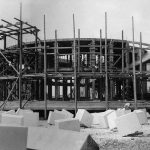It seems that the long tale of the closure of the only automotive history museum in Croatia is coming to an unhappy end.
We’ve reported about this previously, as this is an ugly story that has been dragging on for quite a long period, but it seems that differences in opinions, reduced funding, lack of proper contracts and paperwork and stubbornness of people in charge have finally spelled the ending of a first Croatian automotive history museum, Ferdinand Budicki Automobile Museum in Zagreb. The museum was opened in 2013, when a group of enthusiasts invested around one million kuna to get the completely ruined 1500 square meters of the former Pluto factory halls into shape to host the collection of old-timer cars. The museum was named after the man who is considered to be the first driver in Croatia, first Croatian person to pass a driver’s test and one of the founders of Croatian Automotive Club.
Recently, the City of Zagreb has withdrawn all funding for the museum, and is asking that all objects and exhibitions be removed from the premises that still belong to the city. The museum was formally run by the Association of citizens (“Udruga”), whose accounts have been frozen due to the debt. Valentino Valjak, president of the Association and manager of the museum says that most of the debt accumulated is to the city of Zagreb, which is refusing to finance or help the museum in any way, and his conclusion is that the city is leaving this particular museum to fail because of the personal vendetta against him. He is adding that the city is helping many other private museums both financially and in other ways, while destroying their museum.
Some of those vendetta claims were almost substantiated by a statement from Zagreb Mayor, Milan Bandić, who said that he was the world’s biggest fan of old-timers, and that the Ferdinand Budicki museum will continue to operate, either at the same location or somewhere else, but that it will not be privatised and miss-managed by the gentleman who has been managing it thus far. The person who was in charge until now will be removed from the location he has occupied, and then another person will be found to run the museum with love, Bandić concluded.
There is a weird story of a fire in there as well, which this author is completely unable to understand. Mr. Valjak, current (former?) museum manager claims that it was a false alarm, that there was no fire, that someone reported the fire to damage him and the museum’s reputation. However, the fire department vehicles were sent to the location, where they found a very small fire resulting from someone forgetting about warming-up their lunch? And now Mayor Bandić is using that fire as a proof of poor management.
So, what’s the situation now? The Municipal Services Officers are removing the signs and ads for the museum (because, apparently, that’s the logical first step), the museum is set to be fully closed on February 27th, the museum will be open for the Night of the Museums on January 26th, and what will happen to the museum, the venue designed specifically for that purpose by the volunteers (maybe we should mention that the City Office of emergency management is located at the same address as the museum and that some claim that the entire motivation behind this closure of the museum is their desire to spread to the museum’s square meters) and the exhibits is just about anyone’s guess. The best advice anyone can give now is to go to the museum as soon as possible if you’re into old-timers and still haven’t seen what Ferdinand Budicki Museum has to offer.









